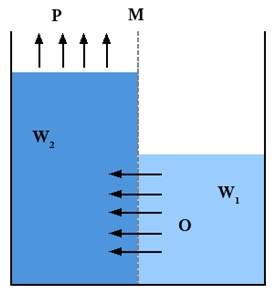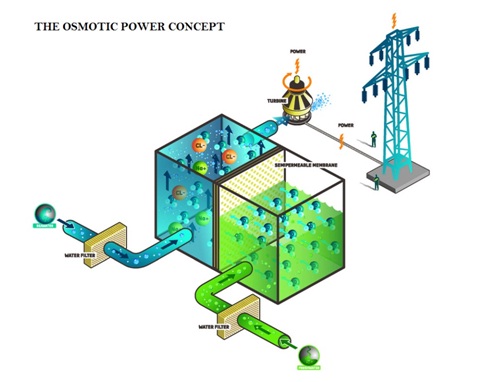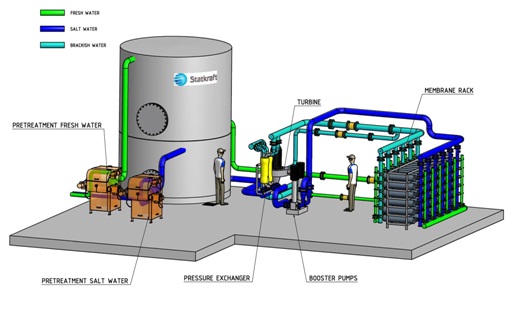





Published on Apr 02, 2024
Energy consumption is an important aspect in our day to day life. Energy consumption rate is increasing very rapidly everyday .If this continues as such then the world will one day face shortage of energy. So its time to look for more sources of energy rather than the non-renewable sources of energy and reduce the rate of consumption of non-renewable energy. There are many forms of renewable energy sources in the world. The abundant renewable energies include solar energy, tidal energy, wind energy, Geo thermal energy etc. One of the most recent power generation techniques is osmotic power generation.
Osmotic power or salinity gradient power is the energy available from the difference in the salt concentration between seawater and river water. Salinity gradient power is a specific renewable energy alternative that creates renewable and sustainable power by using naturally occurring processes
The basic principle involved in osmotic power generation is OSMOSIS. Osmosis is the movement of solvent molecules through a selectively permeable membrane into a region of higher solute concentration, aiming to equalize the solute concentrations on the two sides. It may also be used to describe a physical process in which any solvent moves, without input of energy, across a semi permeable membrane (permeable to the solvent, but not the solute) separating two solutions of different concentrations.

Salinity gradient energy is based on using the resources of “osmotic pressure difference between fresh water and sea water.”All energy that is proposed to use salinity gradient technology relies on the evaporation to separate water from salt. Osmotic pressure is the "chemical potential of concentrated and dilute solutions of salt". When looking at relations between high osmotic pressure and low, solutions with higher concentrations of salt have higher pressure.
Two practical methods for osmotic power generation are reverse electro dialysis (RED) and pressure-retarded osmosis. (PRO).
A method being developed and studied is reversed electro dialysis or reverse dialysis, which is essentially the creation of a salt battery. This method was described by Weinstein and Leitz as “an array of alternating anion and cation exchange membranes can be used to generate electric power from the free energy of river and sea water.”
The technology related to this type of power is still in its infant stages, even though the principle was discovered in the 1950s. Standards and a complete understanding of all the ways salinity gradients can be utilized are important goals to strive for in order make this clean energy source more viable in the future
One method to utilize salinity gradient energy is called pressure-retarded osmosis. In this method, seawater is pumped into a pressure chamber that is at a pressure lower than the difference between the pressures of saline water and fresh water. Freshwater is also pumped into the pressure chamber through a membrane, which increase both the volume and pressure of the chamber. As the pressure differences are compensated, a turbine is spun creating energy.
This method is being specifically studied by the Norwegian utility Statkraft, which has calculated that up to 25 TWh/yr would be available from this process in Norway. Statkraft has built the world's first prototype osmotic power plant on the Oslo fiord which was opened by Her Royal Highness Crown Princess Mette-Marit of Norway on November 24, 2009. It aims to produce enough electricity to light and heat a small town within five years by osmosis. At first it will produce a minuscule 4 kilowatts – enough to heat a large electric kettle, but by 2015 the target is 25 megawatts – the same as a small wind farm.

The components of osmotic power prototype are
a) The pre-treatment equipments

Fig 4a Sea water pretreatment Fig4b Fresh water pretreatment
The incoming fresh water and sea water are purified by using these equipments before being fed into the plant.
b) Membrane Modules: Thin membranes rolled membranes for osmosis
The membranes employed are mainly of two types of:
A cellulose acetate membrane was prepared as following: the casting solution is cast on a glass plate and immersed in ice cold water after solvent evaporation. After solidification the membrane is annealed between 80° and 95°C. A typical casting solution, according to a GKSS patent, consists out of cellulose diacetate, cellulose triacetate, dioxane, acetone, acetic acid and methanol. This composition was kept, but due to changing the casting parameters, both in the lab and in pilot scale, the performance was improved. Casting parameters like casting speed, changes in the temperature of the coagulation bath and also the changes of the support material led to the improved performance. Starting with a membrane performance of approximately 0.5 W/m2, this type of membrane was improved to a performance of close to 1.3 W/m2.
TFC membranes are made by the interfacial polymerisation of trimesoylchloride and m-phenylene diamine. Starting with a membrane performance of approximately 0.1 W/m2, this type of membrane was improved to a performance of close to 3.5 W/m2.
One particularly efficient type of pressure exchanger is a rotary pressure exchanger. This device uses a cylindrical rotor with longitudinal ducts parallel to its rotational axis. The rotor spins inside a sleeve between two end covers. Pressure energy is transferred directly from the high pressure stream to the low pressure stream in the ducts of the rotor. Some fluid that remains in the ducts serves as a barrier that inhibits mixing between the streams. This rotational action is similar to that of an old fashioned machine gun firing high pressure bullets and it is continuously refilled with new fluid cartridges. The ducts of the rotor charge and discharge as the pressure transfer process repeats itself
In the PRO process, water with no or low salt gradient is fed into the plant and filtered before entering the membrane modules using the pre-treatment equipments. Membrane modules could contain spiral wound or hollow fibre membranes. In the module, 80–90% of the water with low salt gradient is transferred by osmosis across the membrane into the pressurised salty water. The osmotic process increases the volumetric flow of high pressure water and is the key energy transfer in the power production process. This requires membranes with particularly high water flux and excellent salt retention properties.
The illustration in figure shows salty water pumped from the sea and filtered before it is pressurised and fed into the membrane module. In the module it is diluted by the water received from the less salty side of the membrane. The volumetric feed of salty water is about twice that of the fresh water.
The diluted and now brackish water from the membrane module is split in two flows. While 1/3 of the brackish water is fed though the turbine to generate power, 2/3 is returned and energy is recycled in the pressure exchanger to add pressure to the feed of salty water. Optimal operating pressures are in the range of 11–15 bars, equivalent to a water head of 100–145 metres in a hydropower plant, enabling the generation of 1 MW per m3 s fresh water. The fresh water feed operates at ambient pressure.
Pre-treatment of the water will be necessary depending on the water qualities. In Norwegian water treatment plants, mechanical filtration down to 50 μm, in combination with a standard cleaning and maintenance cycle has been enough to sustain the membrane performance for 7–10 years.
Osmotic power plants can be constructed anywhere freshwater flows out into the sea, provided that the salt concentration is sufficiently high. Unlike solar power and wind power, osmotic power plants are not affected by fluctuations in the weather and will produce continuous and predictable electricity. Most river outlets around the world represent a potential location for a plant, even though some rivers need more cleaning of the water than others.
The global potential is estimated to be 1,600-1,700 TWh – equivalent to 50% of EU’s total annual power generation today. In Norway alone, it would be able to generate 12 TWh per year –equivalent to around 10% of our total power consumption. Osmotic power can become an important contributor to the generation of clean, renewable energy.
Around the world, rivers flow out into the sea in urban and industrial areas where it will be possible to construct osmotic power plants. A power plant the size of a football stadium could supply around 30,000 households with electricity. These power plants can be built underground, e.g. in the basement of an industrial building or under a park, minimizing their visual impact. Osmotic power plants produce renewable energy with no polluting discharges to the atmosphere or water. In coming years use of renewable energies and thus conserving energy has to be promoted hugely .Osmotic power generation is indeed a promising technique with immense potential worldwide.
1. Osmotic power — power production based on the osmotic pressure difference between waters with varying salt gradients Stein Erik Skilhagen*, Jon E. Dugstad, Rolf Jarle Aaberg Statkraft Development AS, Lilleakerveien 6, No-0216 Oslo, Norway
2. Membrane processes in energy supply for an osmotic power plant Karen Gerstandta, K.-V. Peinemanna*, Stein Erik Skilhagenb, Thor Thorsenc, Torleif Holtc
3. www.statkraft.com
| Are you interested in this topic.Then mail to us immediately to get the full report.
email :- contactv2@gmail.com |